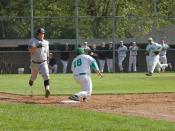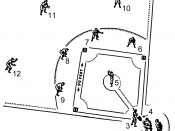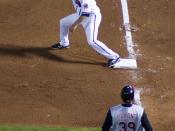Avoiding Injuries One ball with a sewn cloth cover, a baseball bat made from wood and a heavy glove made of rawhide. These are all objects used in the game of baseball. When playing baseball there are only 2 teams, one team plays defense and the other team plays offense. If you do not know how to play baseball then you might get injured.
When you play defense 9 players are required on the field, no more, no less. If you have more players then necessary, you would run into each other and cause an accident. Each player has their own position. If you have more than one player in a position at a time, you might get mixed up and bump heads running for the ball. These positions consist of a pitcher, catcher, second baseman, first baseman, third baseman, shortstop, left fielder, right fielder and a center fielder. When you are in one of these positions, it is your responsibility to play a certain area so if the ball gets hit to your area you are able to retrieve it.
If you didn't stay in your own area, you might collide with another player and injure yourself. A pitcher will put the ball in play by throwing the ball at the stationary catcher in various attempts to strike out a batter that is on the offense. The catcher must pay particular attention to the pitcher, if not he could get hit on the head with the ball and possibly suffer a concussion. If the pitcher throws the ball to the catcher, and the batter hits it, then every player on the defense must watch the ball to see where it is headed. If the ball is headed towards left field, then the left fielder will retrieve the ball and try to throw it towards a baseman where the batter is running. If anyone else tries to retrieve the ball they might run into the left fielder resulting in a collision. If the left fielder is able to get the ball to the baseman before the baseman gets there, then the batter is out. The baseman must be paying attention to the left fielder in case he throws the ball to him. If the baseman isn't paying attention, again, he could get hit with the ball and become seriously injured. This is only true for first baseman, or if there is another batter behind him pushing him forward towards the next base.
If the left fielder can not throw the ball to the base, which the batter is running towards, then that batter will be safe. On the other hand, if the left fielder catches the ball before it hits the ground, then the batter is also out. If the left fielder is not paying attention when the batter hits the ball, the ball coming towards him might hit him. These rules also apply to the other players on the defense. The basemen must stay close to their bases so if the ball gets hit to someone, the person who gets the ball can throw it to a baseman and get the runner out. If the runner is not paying attention to the ball he also runs a risk of being hit by it.
The pitcher must also throw the ball within a certain area in front of the catcher called the "batter's box." This is a box, which the batter stands in, and has an area for the ball to be thrown into. If the ball is thrown outside of this area and the batter does not try to swing at it, then this play is considered a "ball". In this case, the batter must be ready to jump out of the way because the ball might hit him. If the ball is in this area and the batter does not swing at it then this play is considered a "strike". The pitcher might try to fool the batter by throwing variations of pitches. The catcher must watch where he is positioned so he doesn't get hit in the head with the bat being swung by the batter. If the pitcher can make the batter swing three times without hitting the ball or put the ball in the "strike zone" the batter will be out. If the pitcher throws four balls at the batter which are outside of the "strike zone" and the batter does not swing, then the batter gets to go to first base. If the pitcher hits the batter with the ball the batter "walks" to first base. If there is a runner on a base the pitcher must watch him. If the runner tries to run towards another base without the batter hitting the ball then the runner is considered to be "stealing a base". This allows the pitcher to try to throw the ball to the base in which the runner is headed, so the baseman can tag him "out". The runner must be wary when running to the base because he has a chance to get hit by the ball the pitcher is throwing. Sometimes the pitcher can try to fool the runner by faking the pitch and throwing it to the base that the runner is at. Again, the runner must be watching at all times because, he can get hit by the ball. If the ball gets to this base and the runner does not have his foot on the base he is considered "out". If the pitcher gets tired or gets injured during the game, another pitcher from the same team can relieve him. Fielders can also relieve fielders that suffer from fatigue or an injury.
The fielders must work together to stop the offense from scoring. If all players cooperate and help each other, then the probability of injury's decreases and the opportunity to win increases.
Offense is the opposite, of defense you must score runs in order to win the game. After the defense makes the third out they get a chance to be on offense until they receive three "outs". This will go on for approximately Nine innings. Once your team is on offense you have a batting order generally in order of the better hitters starting first. The offense starts by putting the first batter up to the batter's box to which he will be thrown a variety of pitches from the pitcher. The batter must wear a helmet at all times because the ball comes very close to hitting him every time he is in the batter's box.
The batter takes his position with his wooden bat in hand to hit the ball. The batter must watch the ball very carefully in order to determine if the ball is in the "strike zone" and to make sure it will not hit him. If the ball is in the "strike zone," the batter will swing at the ball and try to hit it. If the batter makes contact with the ball he must run towards first base and touch it with his foot. The batter must be careful when running to the base if he has not warmed up, or stretched out because he might pull a muscle. If the batter thinks he has more time, he can run to second base for a closer chance to score a run. While running, he must know where the ball is so he can reduce the risk of being hit. Once the batter is on a base, he must stay there until the ball is struck. If there is a runner behind him that runner must run ahead to the next base. If there is no runner behind him he can choose to run or stay on the base. The runner must also be aware of the other runners so that they do not collide with each other. If the pitcher catches him, the pitcher will try to throw the ball towards the base which the runner is headed for. The runner must be tagged by the baseman, with the hand that has the ball, in order to be "out". The batter must watch this, because he might get hit with the ball in the process. Once the runner has made it to third base, he has a chance to score. If the batter can hit the ball far enough, the runner can run to the home plate to score. The pitcher or basemen must be careful not to stand in the way of the runner unless they have the ball because they have a chance to be trampled on by the runner. The batter can also score if he can hit the ball far enough to go over the back wall where the people are sitting. If you sit in the stands watching the game you must also be paying attention because you too can get hit with the ball. If the batter can hit the ball over the wall then the batter automatically gets to run around the bases to "home plate" to score. If there is someone on base when the batter hits the ball over the wall, they will both score. If the batter hits the ball high but not far enough, the ball may be caught by the defense for an "out". If the batter hits the ball but, cannot make it to the base before one of the defense men throw the ball to it, then the batter is also out. The batter may try to stick out his bat without swinging in order to try to tap the ball lightly, and then run to a base. The batter must be cautious when doing this, for the ball might hit him. This is called a "bunt" and is usually used when the offense wants to move a runner closer to a scoring position.
The offense isn't as complicated as the defense but it takes great skill in both offense and defense to win a game and avoid injury. The team who has the highest number of batters to cross the home plate will win the game. If the baseball game is tied then it will go into extra innings until one team has won.
As you can see baseball is fun but it follows rules and guidelines that each player has to abide by otherwise, it might result in injury. These are the basics to baseball when playing offense and defense and they give a better understanding of the game so that you won't get hurt. Next time when you are playing or watching a baseball game, you will have a better understanding of the game and the importance of baseball rules.





